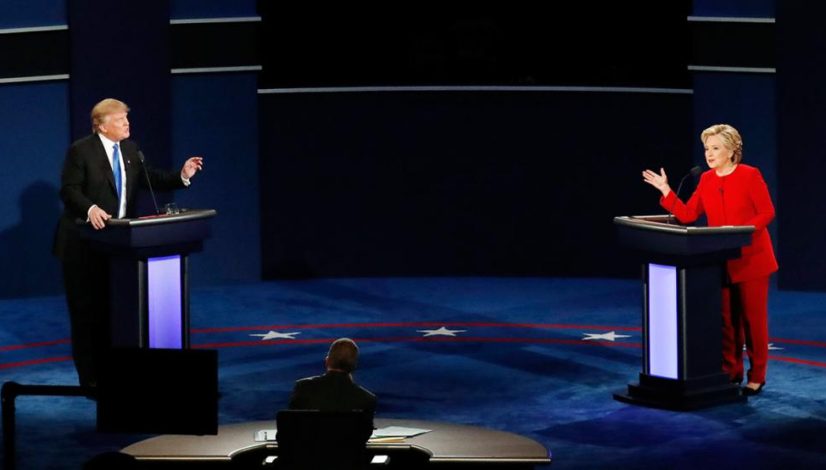Hillary Has Lock on the Black Vote, but May Have Alienated White Voters
NBC anchor Lester Holt did Hillary Clinton a big favor on Monday night when he brought up the “birther” issue, asking Donald Trump why it had taken so long for the GOP candidate to acknowledge Obama’s legitimacy. Most people have probably put the birther debate to bed and do not see it as central to the future of the nation. But, the question from the debate moderator allowed Hillary to again denounce Trump as racist and as disrespectful to our (popular) first African-American president.
Holt’s other questions about race gave her an opportunity to repeat her push for criminal justice reform and stricter oversight of our police. Since she is desperate to attract and motivate black voters, it was a win for her. Or was it?
Is there a point at which Hillary’s pursuit of black voters, and especially her attacks on law enforcement, will turn off white voters? As Dick Morris relates in Armageddon, Mitt Romney lost in 2012 because white turnout tanked. Between 2004 and 2012, according to Morris, “white voter turnout dropped by 10 million and black and Hispanic turnout rose by four million.” Romney carried the white vote 61 percent to 39 percent but “ten million stayed home.”
As Morris correctly argues, Trump’s number one ambition is to drive white turnout higher. He has already proved that he can do that, by talking up law and order and with his emphasis on jobs. Morris points out that the newly registered voters showing up to participate in the primaries are exactly the ones who sat out the last race. With her incessant outreach to blacks, Clinton may be giving Trump an important assist.
A recent ABC News\Washington Post poll found Donald Trump leading Hillary Clinton among white men without college degrees by 76 percent to 17 percent — a crushing 59-point lead, up from 47 points just a few weeks ago. Romney won this group by 31 points in 2012. Overall, Trump leads Clinton by 16 points with white voters. That is formidable.
Bill Clinton gets that, and is hitting the campaign trail this week in Florida to corral white Democrats. As Politico reported a couple of months ago, “The presumptive nominee’s husband is “singularly obsessed” with bringing back to the fold white voters who twice elected him to the Oval Office.”
That could prove critical, especially if Hillary Clinton’s muddled message to blacks fails to excite that constituency. On the one hand, she argued in the debate that African-Americans are subject to “implicit bias” and that “race still determines too much.”
At the same time, Clinton again mocked Trump’s “dire” portrait of the black community. She cites the “vibrancy of the black church, the black businesses that employ so many people, the opportunities that so many families are working to provide for their kids.” If that is true, why is she advocating spending $125 billion in “targeted investments to create good-paying jobs” to “revitalize the economy in communities that have been left out and left behind?”
In short, she wants it both ways. She wants to tell African-Americans that she will help level an unfair playing field, but at the same time she is panicked that Trump’s portrayal of inner city problems will hit a nerve.
Consequently, she has singled out racism in law enforcement as the safe issue. That’s bipartisan territory, and the path has been paved by President Obama, who has argued that too many young men of color are locked up for non-violent offenses, a charge Clinton repeated in the debate.
Safe, except that the charge is simply not true. There are roughly 2.2 million individuals imprisoned in the U.S., of which about 200,000 are in federal lock-ups. State prisons hold most criminals charged with murder, rape and other violent crimes; consequently, a disproportionate share of federal prisoners are those convicted of drug-related offenses.
These people are not ordinarily “young people who made mistakes that aren’t that different from the mistakes I made,” as President Obama has described them, but more usually traffickers or other repeat offenders who have pled down to lesser charges. Fewer than one percent of those locked up for drug-related crimes in 2014 were jailed for possession.
In state prisons, fewer than 20 percent are jailed for drug-related crimes, and less than 4 percent were in for possession, most likely a reduced charge from plea-bargaining. More than half those jailed stand convicted of violent crimes, while the vast majority of those incarcerated for nonviolent offenses were repeat offenders.
The reality is reflected in President Obama’s rush to pardon criminals in federal prison. On August 3, Obama pardoned 214 people – the most ever in a single day — bringing the total for his time in office to 562. They were described as “mostly non-violent” and by CNN as “drug offenders.” But nearly one quarter of those released were convicted of gun charges; that’s a far cry from an innocent teen locked up for smoking weed.
Hillary Clinton’s embrace of criminal justice reform and stricter oversight of police plays well with the black community and those sympathetic to the charge that our law enforcement is biased. But in Charlotte, North Carolina, site of another police shooting of a black man, scenes of rioting and the savage beating and dragging of a white man by a black mob, could alarm whites.
Crime is on the rise, as Trump correctly noted in Monday’s debate. The FBI reports that murders rose almost 11 percent in 2015 over the year before, with cities including Baltimore (up 63 percent), Milwaukee (up 61 percent) and Washington, D.C. (up 54 percent) accounting for much of the rise. People may begin to wonder if abandoning Stop & Frisk was a good idea after all.
If she continues down this path, Hillary could win the black vote, but lose the election. Which goes to show, we actually are stronger together.
Published here.




